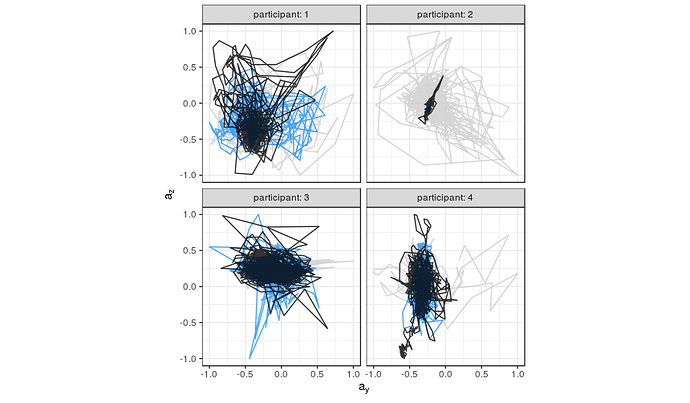The simple answer is that @ron's example code will draw the same type of diagram. The challenge comes in tweaking the details. It's a little hard to make out what's going on in the original plot due to the resolution of the screenshot being low (can you possibly get a higher-res screenshot?), but what I see:
- The g values may have been rescaled or normalized
- The four plots have different x and y axis limits, and different main panel sizes. This probably means they were created independently of each other, and then composed into this grid as a separate step
- I have no idea what the colors represent. Is there a caption or legend with the original plot that might explain it? Without knowing this, it's hard to guess how to recreate the effect.
- The lines are very smooth and loopy — maybe tree branches accelerate this way (?), but I wonder if the data has been smoothed somehow.
I found some accelerometer data to play with, and so far this is the best I've got. Here, the colors just indicate the order in which the readings were taken (earliest = gray, mid = blue, latest = black).
library(tidyverse)
# Data downloaded from:
# https://archive.ics.uci.edu/ml/machine-learning-databases/00287/Activity%20Recognition%20from%20Single%20Chest-Mounted%20Accelerometer.zip
# Metadata:
# https://archive.ics.uci.edu/ml/datasets/Activity+Recognition+from+Single+Chest-Mounted+Accelerometer
file_list <- list.files(
"Activity Recognition from Single Chest-Mounted Accelerometer/",
pattern = "\\.csv$",
full.names = TRUE
)
accel <- map_dfr(
file_list,
read_csv,
col_names = c("id", "x", "y", "z", "activity"),
col_types = "nnnnn",
.id = "participant"
) %>%
mutate(
activity = factor(
activity,
labels = c(
"Working at Computer",
"Standing Up, Walking and Going Up/Down Stairs",
"Standing",
"Walking",
"Going Up/Down Stairs",
"Walking and Talking with Someone",
"Talking while Standing"
),
exclude = "0"
),
participant = factor(participant, levels = as.character(1:15))
) %>%
filter(!is.na(activity))
hz <- 52 # frequency of readings
three_mins <- (3 * 60) * hz
# Filter data to manageable subset and prep for plotting
accel_3min <- accel %>%
filter(participant %in% c(1:4), activity == "Standing") %>%
group_by(participant) %>%
slice(1:three_mins) %>%
mutate(
x = scales::rescale(x, to = c(-1, 1)),
y = scales::rescale(y, to = c(-1, 1)),
z = scales::rescale(z, to = c(-1, 1)),
id = row_number()
)
# Color first third of readings lightest color, second third mid color,
# last third darkest color
accel_3min %>%
ggplot() +
geom_path(aes(x = y, y = z, colour = cut(id, 3)), alpha = 0.8, size = 0.5) +
facet_wrap( ~ participant, labeller = label_both) +
coord_fixed() +
scale_color_manual(
values = c("gray80", "dodgerblue", "black"),
guide = "none"
) +
theme_bw() +
labs(x = expression(a[y]), y = expression(a[z]))
If anybody else wants to play with this, I put my attempt in a shared RStudio Cloud project:
